Vatican frescoes by Raphael
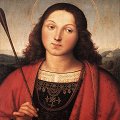 Raphael is an Italian High
Renaissance painter and architect of the Florentine school, celebrated
for the perfection and grace of his art. His work is
admired for its clarity of form and ease of composition and for its
visual achievement of the Neoplatonic ideal of human grandeur. Raphael
is one of the most famous artists of High Renaissance and one of the
greatest influences in the history of Western art.
Raphael is an Italian High
Renaissance painter and architect of the Florentine school, celebrated
for the perfection and grace of his art. His work is
admired for its clarity of form and ease of composition and for its
visual achievement of the Neoplatonic ideal of human grandeur. Raphael
is one of the most famous artists of High Renaissance and one of the
greatest influences in the history of Western art.
Raphael rooms in Vatican
The four rooms known as the Stanze of Raphael formed part of the apartment situated on the second floor of the Pontifical Palace that was chosen by Julius II della Rovere (pontiff from 1503 to 1513) as his own residence and used also by his successors. The pictorial decoration was executed by Raphael and his school between 1508 and 1524.
- The School of Athens (Detail 3) (1509)
- The School of Athens (Detail 4) (1509)
- The School of Athens (Detail) (1509)
- Apollo and Marsyas (Ceiling Panel) (1511)
- Gregory IX Approving the Decretals (1511)
- Justice (Ceiling Tondo) (1511)
- La Disputa (Detail) (1511)
- Philosophy (Ceiling Tondo) (1511)
- Poetry (Ceiling Tondo) (1511)
- The Judgment of Solomon (Ceiling Panel) (1511)
- Theology (Ceiling Tondo) (1511)
- Adam and Eve (Ceiling Panel) (1511)
- The Expulsion of Heliodorus from the Temple (Detail) (1512)
- The Mass at Bolsena (Detail 2) (1512)
- The Mass at Bolsena (Detail 3) (1512)
- The Mass at Bolsena (Detail) (1512)
- The Mass at Bolsena (1512)
- The Liberation of St. Peter (Detail 2) (1514)
- The Liberation of St. Peter (Detail 3) (1514)
- The Liberation of St. Peter (Detail 4) (1514)
- The Fire in the Borgo (Detail) (1514)
- The Judgment of Solomon (1519)
- Vision of the Cross (Detail) (1520)
Room of the Segnatura
The Room of the Segnatura contains Raphael's most famous frescoes. Besides being the first work executed by the great artist in the Vatican they mark the beginning of the High Renaissance. The room takes its name from the highest court of the Holy See, the "Segnatura Gratiae et Iustitiae", which was presided over by the pontiff and used to meet in this room around the middle of the 16th century. Originally the room was used by Julius II (pontiff from 1503 to 1513) as a library and private office.
The iconographic programme of the frescoes, which were painted between 1508 and 1511, is related to this function. It was certainly established by a theologian and meant to represent the three greatest categories of the human spirit: Truth, Good and Beauty. Supernatural Truth is illustrated in the Disputation of the Most Holy Sacrament (theology), while rational Truth is illustrated in the School of Athens (philosophy). Good is expressed in the Cardinal and Theological Virtues and the Law. Beauty is represented in the Parnassus with Apollo and the Muses. The frescoes of the ceiling are connected with the scenes below them. The allegorical figures of Theology, Philosophy, Justice and Poetry allude in fact to the faculties of the spirit painted on the corresponding walls.
Under Leo X (pontiff from 1513 to 1521) the room was used as a small study and music room, in which the pontiff also kept his collection of musical instruments. The original furnishings of the time of Julius II were removed and replaced with a new wooden wainscot, the work of Fra Giovanni da Verona. The wood covered all the walls with the exception of that of the Parnassus, where, for reasons of space, the same decoration, still visible today, was painted in fresco. The wooden wainscot was probably destroyed following the Sack of Rome in 1527 and in its place, during the pontificate of Paul III (pontiff from 1534 to 1549) a wainscot in chiaroscuro was painted by Perin del Vaga.
The School of Athens
The School of Athens is one of the most famous paintings by Raphael. The Stanza della Segnatura was the first of the rooms to be decorated, and The School of Athens the second painting to be finished after La disputa.
The School of Athens (Detail 3) (1509)
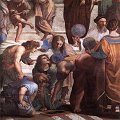 Get
Get  a high-quality picture of
The School of Athens (Detail 3) for your computer or notebook. ‣
Geometry is represented by Euclid, who is explaining to his pupils a geometric diagram he has drawn on a slate. It is thought that Raphael was here portraying the architect Bramante.
a high-quality picture of
The School of Athens (Detail 3) for your computer or notebook. ‣
Geometry is represented by Euclid, who is explaining to his pupils a geometric diagram he has drawn on a slate. It is thought that Raphael was here portraying the architect Bramante.
The School of Athens (Detail 4) (1509)
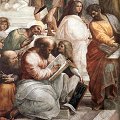 Get
Get  a high-quality picture of
The School of Athens (Detail 4) for your computer or notebook. ‣
Pythagoras, representing Arithmetic, is sitting in the foreground. The two men who are jostling to look over his shoulder recall figures in Da Vinci's unfinished Adoration of the Magi in the Uffizi. Raphael had occasion to study Leonardo's picture during his stay in Florence.
a high-quality picture of
The School of Athens (Detail 4) for your computer or notebook. ‣
Pythagoras, representing Arithmetic, is sitting in the foreground. The two men who are jostling to look over his shoulder recall figures in Da Vinci's unfinished Adoration of the Magi in the Uffizi. Raphael had occasion to study Leonardo's picture during his stay in Florence.
The School of Athens (Detail) (1509)
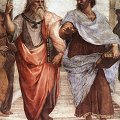 Get
Get  a high-quality picture of
The School of Athens (Detail) for your computer or notebook. ‣
Plato and Aristotle are standing in the centre of the picture at the head of the steps. Diogenes is lying carefree on the steps to show his philosophical attitude: he despised all material wealth and the lifestyle associated with it. Below on the right is a great block of stone whose significance is probably connected with the first epistle of St Peter. It symbolizes Christ, the "cornerstone" which the builders have rejected, which becomes a stumbling block and a "rock of offence" to the unbeliever.
a high-quality picture of
The School of Athens (Detail) for your computer or notebook. ‣
Plato and Aristotle are standing in the centre of the picture at the head of the steps. Diogenes is lying carefree on the steps to show his philosophical attitude: he despised all material wealth and the lifestyle associated with it. Below on the right is a great block of stone whose significance is probably connected with the first epistle of St Peter. It symbolizes Christ, the "cornerstone" which the builders have rejected, which becomes a stumbling block and a "rock of offence" to the unbeliever.
Apollo and Marsyas (Ceiling Panel) (1511)
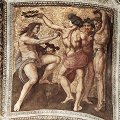 Get
Get  a high-quality picture of
Apollo and Marsyas (Ceiling Panel) for your computer or notebook. ‣
The shepherd Marsyas had challenged the god Apollo to a musical contest. Marsyas lost and as a punishment for daring to challenge a god he was flayed alive. The scene is an allegory of divine harmony triumphing over earthly passion. With its unrhythmical composition and its elongated figures, this scene is probably by an unknown hand, and not by Raphael.
a high-quality picture of
Apollo and Marsyas (Ceiling Panel) for your computer or notebook. ‣
The shepherd Marsyas had challenged the god Apollo to a musical contest. Marsyas lost and as a punishment for daring to challenge a god he was flayed alive. The scene is an allegory of divine harmony triumphing over earthly passion. With its unrhythmical composition and its elongated figures, this scene is probably by an unknown hand, and not by Raphael.
Gregory IX Approving the Decretals (1511)
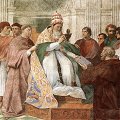 Get
Get  a high-quality picture of
Gregory IX Approving the Decretals for your computer or notebook. ‣
This scene is based on a dedication picture of the kind often found in manuscript illumination. What is unusual is that Pope Julius II allowed himself to be portrayed as Pope Gregory IX. His beard helps the dating of the fresco since it is known that after the autumn of 1511 he never shaved again. Cardinal Giovanni de' Medici, later to be Leo X, is standing on the pope's far left.
a high-quality picture of
Gregory IX Approving the Decretals for your computer or notebook. ‣
This scene is based on a dedication picture of the kind often found in manuscript illumination. What is unusual is that Pope Julius II allowed himself to be portrayed as Pope Gregory IX. His beard helps the dating of the fresco since it is known that after the autumn of 1511 he never shaved again. Cardinal Giovanni de' Medici, later to be Leo X, is standing on the pope's far left.
Justice (Ceiling Tondo) (1511)
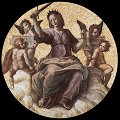 Get
Get  a high-quality picture of
Justice (Ceiling Tondo) for your computer or notebook. ‣
The personification of Justice is holding, as her symbols, weighing scales and a sword. Her eyes are directed at the fresco below, The Virtues, in which Fortitude, Wisdom, and Temperance are portrayed in the form of three women. Taken together, all four personifications represent the Cardinal Virtues. Justice's prominent position is explained by the fact that Justice was said by Plato to play a decisive role among the virtues. Two putti are holding the inscription with the words of Emperor Justinian, "She gives Justice to all."
a high-quality picture of
Justice (Ceiling Tondo) for your computer or notebook. ‣
The personification of Justice is holding, as her symbols, weighing scales and a sword. Her eyes are directed at the fresco below, The Virtues, in which Fortitude, Wisdom, and Temperance are portrayed in the form of three women. Taken together, all four personifications represent the Cardinal Virtues. Justice's prominent position is explained by the fact that Justice was said by Plato to play a decisive role among the virtues. Two putti are holding the inscription with the words of Emperor Justinian, "She gives Justice to all."
La Disputa (Detail) (1511)
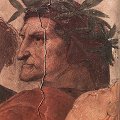 Get
Get  a high-quality picture of
La Disputa (Detail) for your computer or notebook. ‣
Dante Alighieri was one of the first humanists and one of the originators of the Early Renaissance. His Divine Comedy, a verse epic from 1320, was regarded as a theological work in Raphael's time, which is why in the Stanza della Segnatura the poet is included among the famous men of the Church.
a high-quality picture of
La Disputa (Detail) for your computer or notebook. ‣
Dante Alighieri was one of the first humanists and one of the originators of the Early Renaissance. His Divine Comedy, a verse epic from 1320, was regarded as a theological work in Raphael's time, which is why in the Stanza della Segnatura the poet is included among the famous men of the Church.
Philosophy (Ceiling Tondo) (1511)
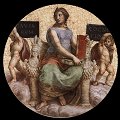 Get
Get  a high-quality picture of
Philosophy (Ceiling Tondo) for your computer or notebook. ‣
The woman enthroned is enveloped in a garment that has four colours, each of which represents one of the four elements, which in turn are symbolized by their pattern. Blue is for the stars (air), red is for the tongues of flame (fire), green is for the fish (water), and golden brown is for the flora (earth). Philosophy holds two books with the titles "Morals" and "Nature," while two genii hold texts with Cicero's words Causarum Cognitio (Know the Causes). This picture is situated above The School of Athens.
a high-quality picture of
Philosophy (Ceiling Tondo) for your computer or notebook. ‣
The woman enthroned is enveloped in a garment that has four colours, each of which represents one of the four elements, which in turn are symbolized by their pattern. Blue is for the stars (air), red is for the tongues of flame (fire), green is for the fish (water), and golden brown is for the flora (earth). Philosophy holds two books with the titles "Morals" and "Nature," while two genii hold texts with Cicero's words Causarum Cognitio (Know the Causes). This picture is situated above The School of Athens.
Poetry (Ceiling Tondo) (1511)
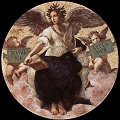 Get
Get  a high-quality picture of
Poetry (Ceiling Tondo) for your computer or notebook. ‣
The lyre and the laurel wreath are the symbols of Poetry, who here appears as a winged figure. Like Aristotle in The School of Athens, she is holding a book in an unusual way; the title is not known. Two putti are holding the tablets on which are written the words of the Roman poet Virgil's, "Numine Afflatur" (Inspired by the Spirit). The Christian "spirit" is meant here, since putti are holding the text and not genii, as with the figure of Philosophy.
a high-quality picture of
Poetry (Ceiling Tondo) for your computer or notebook. ‣
The lyre and the laurel wreath are the symbols of Poetry, who here appears as a winged figure. Like Aristotle in The School of Athens, she is holding a book in an unusual way; the title is not known. Two putti are holding the tablets on which are written the words of the Roman poet Virgil's, "Numine Afflatur" (Inspired by the Spirit). The Christian "spirit" is meant here, since putti are holding the text and not genii, as with the figure of Philosophy.
The Judgment of Solomon (Ceiling Panel) (1511)
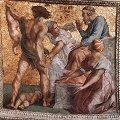 Get
Get  a high-quality picture of
The Judgment of Solomon (Ceiling Panel) for your computer or notebook. ‣
The story from the Old Testament tells how two women came to Solomon to settle a dispute about which one was the mother of a child. When Solomon ordered the baby to be cut in half, one of the women agreed to give up the child. Solomon recognized her as the true mother. The man holding the sword derives from a classical figure, either Castor or Pollux from the Quirinal, an ancient Roman palace.
a high-quality picture of
The Judgment of Solomon (Ceiling Panel) for your computer or notebook. ‣
The story from the Old Testament tells how two women came to Solomon to settle a dispute about which one was the mother of a child. When Solomon ordered the baby to be cut in half, one of the women agreed to give up the child. Solomon recognized her as the true mother. The man holding the sword derives from a classical figure, either Castor or Pollux from the Quirinal, an ancient Roman palace.
Theology (Ceiling Tondo) (1511)
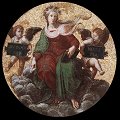 Get
Get  a high-quality picture of
Theology (Ceiling Tondo) for your computer or notebook. ‣
Theology's veil is white, her cloak green, and her dress red, the colours of the theological Virtues (Faith, Hope, and Charity). She is holding a book in her left hand and is pointing with her right hand at the fresco of the Disputa below. Two putti are holding blue tablets with the golden inscriptions Divinar, Rer and Notitia ("Knowledge of Divine Things").
a high-quality picture of
Theology (Ceiling Tondo) for your computer or notebook. ‣
Theology's veil is white, her cloak green, and her dress red, the colours of the theological Virtues (Faith, Hope, and Charity). She is holding a book in her left hand and is pointing with her right hand at the fresco of the Disputa below. Two putti are holding blue tablets with the golden inscriptions Divinar, Rer and Notitia ("Knowledge of Divine Things").
Adam and Eve (Ceiling Panel) (1511)
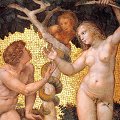 Get
Get  a high-quality picture of
Adam and Eve (Ceiling Panel) for your computer or notebook. ‣
This portrayal of the Fall is generally attributed to Raphael. Standing in a distinct contrapposto pose, Eve recalls the figure of Leda in a study by Da Vinci - Raphael made a drawing of this while he was in Florence.
a high-quality picture of
Adam and Eve (Ceiling Panel) for your computer or notebook. ‣
This portrayal of the Fall is generally attributed to Raphael. Standing in a distinct contrapposto pose, Eve recalls the figure of Leda in a study by Da Vinci - Raphael made a drawing of this while he was in Florence.
Room of Heliodorus
This room was originally used for the private audiences of the Pope and was decorated by Raphael immediately after the Segnatura. The room's programme is political and aims at documenting, in different historical moments from the Old Testament to medieval history, the miraculous protection bestowed by God on the Church. Faith had been threatened (Mass of Bolsena), in the person of its pontiff (Liberation of St Peter), in its site (Encounter of Leo the Great with Attila) and in its patrimony (Expulsion of Heliodorus from the temple).
These were also chosen to express the political programme of Julius II (pontiff from 1503 to 1513), aimed at freeing Italy, at the time occupied by the French, to restore the temporal power under threat to the papacy. The four episodes of the Old Testament on the ceiling are the work of Raphael, while in the grotesques and in the arches there are still some parts that can be attributed to Luca Signorelli, Bramantino, Lorenzo Lotto and Cesare da Sesto. They date to the first decoration commissioned by Julius II at the beginning of his pontificate, that was interrupted and then replaced by the present one due to the pontiff's great admiration for the first frescoes of Raphael in the adjoining room of the Segnatura.
The Expulsion of Heliodorus from the Temple (Detail) (1512)
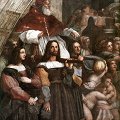 Get
Get  a high-quality picture of
The Expulsion of Heliodorus from the Temple (Detail) for your computer or notebook. ‣
In the Stanza di Eliodoro Raphael enhances his compositions by breaking up the symmetry and the enclosed rhythm of the Stanza della Segnatura with more lively and colourful effects. These trends appear first in the Expulsion of Heliodorus.
a high-quality picture of
The Expulsion of Heliodorus from the Temple (Detail) for your computer or notebook. ‣
In the Stanza di Eliodoro Raphael enhances his compositions by breaking up the symmetry and the enclosed rhythm of the Stanza della Segnatura with more lively and colourful effects. These trends appear first in the Expulsion of Heliodorus.
The focal point of the scene is no longer at the centre. Rather, it is shifted to the right. Here Heliodorus and his followers, profaning the Temple of Jerusalem, are driven out by an armed rider and by two running figures. In the depiction of the rider and the two hovering youths, Raphael follows the text from Maccabees in the Apocrypha exactly. The horse owes a debt to Da Vinci's design for the Battle of Anghiari in the Palazzo Vecchio in Florence.
In the centre, the expanse of the wide nave, illuminated by the reflections of light in the vault, is a more effective space-determining motif than the large patches of blue sky which appeared through the coffered ceiling in the School of Athens.
At the extreme left, Pope Julius II dominates the bystanders, and he reappears in subsequent scenes as well.
Raphael's new compositional formula, so unexpected after the extremely controlled compositions of the Stanza della Segnatura, is visible in all its dynamic evidence from this fresco onward.
The Mass at Bolsena (Detail 2) (1512)
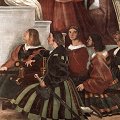 Get
Get  a high-quality picture of
The Mass at Bolsena (Detail 2) for your computer or notebook. ‣
Julius II had founded the Swiss Guard as a military elite in May 1510, and granted them the distinction of their own costume. The Guard had played a vital role in a victory over French forces, who had occupied parts of the Papal State. The pope was probably bestowing an honour on them for that loyal service by letting Raphael portray some of their important representatives in the fresco, thus giving them pride of place in his audience chamber.
a high-quality picture of
The Mass at Bolsena (Detail 2) for your computer or notebook. ‣
Julius II had founded the Swiss Guard as a military elite in May 1510, and granted them the distinction of their own costume. The Guard had played a vital role in a victory over French forces, who had occupied parts of the Papal State. The pope was probably bestowing an honour on them for that loyal service by letting Raphael portray some of their important representatives in the fresco, thus giving them pride of place in his audience chamber.
The Mass at Bolsena (Detail 3) (1512)
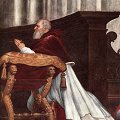 Get
Get  a high-quality picture of
The Mass at Bolsena (Detail 3) for your computer or notebook. ‣
As in The Expulsion of Heliodorus, Raphael here made Julius II a witness of a miracle that took place in the past. On 7 September 1506 Julius had stopped at the cathedral at Orvieto to see the relic of the cloth that was used to wipe the blood from the Eucharist, and thereby to demonstrate his personal connection with the miracle for which Urban IV had instituted the Feast of Corpus Christi.
a high-quality picture of
The Mass at Bolsena (Detail 3) for your computer or notebook. ‣
As in The Expulsion of Heliodorus, Raphael here made Julius II a witness of a miracle that took place in the past. On 7 September 1506 Julius had stopped at the cathedral at Orvieto to see the relic of the cloth that was used to wipe the blood from the Eucharist, and thereby to demonstrate his personal connection with the miracle for which Urban IV had instituted the Feast of Corpus Christi.
The Mass at Bolsena (Detail) (1512)
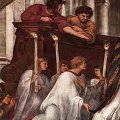 Get
Get  a high-quality picture of
The Mass at Bolsena (Detail) for your computer or notebook. ‣
As the priest raises the Host, two devotees lean over the semicircular screen which forms the background of the scene. This is a further attempt by Raphael to represent figures in a more dynamic way.
a high-quality picture of
The Mass at Bolsena (Detail) for your computer or notebook. ‣
As the priest raises the Host, two devotees lean over the semicircular screen which forms the background of the scene. This is a further attempt by Raphael to represent figures in a more dynamic way.
The Mass at Bolsena (1512)
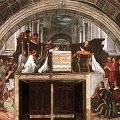 Get
Get  a high-quality picture of
The Mass at Bolsena for your computer or notebook. ‣
Another exceptional event, The Mass at Bolsena is represented after the Expulsion of Heliodorus in the Stanza di Eliodoro. It is the basis of the Catholic ceremony of the Corpus Domini.
a high-quality picture of
The Mass at Bolsena for your computer or notebook. ‣
Another exceptional event, The Mass at Bolsena is represented after the Expulsion of Heliodorus in the Stanza di Eliodoro. It is the basis of the Catholic ceremony of the Corpus Domini.
In 1263 a Bohemian priest, troubled by doubts about the doctrine of transubstantiation (the belief that the body and blood of Christ are present in the Eucharist), started out on a pilgrimage to Rome. On his way he celebrated mass at Bolsena, and during the consecration the Eucharist began, miraculously, to bleed. Each time he wiped the blood away with a cloth a cross of blood would reappear on the Host, a miracle that swept away the priest's doubts. The cloth became a venerated relic and was later kept at Orvieto Cathedral which was rebuilt (in its present form) to honour the occasion.
Raphael represents the priest, the protagonist of the event, close to the centre of the composition. As he raises the Host, two devotees lean over the semicircular screen which forms the background of the scene. This is a further attempt by Raphael to represent figures in a more dynamic way. Some critics believe he was inspired by Lorenzo Lotto, who was among the artists who had begun to paint the Stanza della Segnatura before his intervention. Pope Julius appears at the right of the scene, a symbol of ecclesiastical authority's presence during, and approval of, the miracle. The Pope's attendants stand one step below and behind him.
The asymmetry of the composition regards time as well as space: the excitement of the figures at the left represents a reaction to the supernatural event, which they witness; the stillness of the Pope and his attendants indicates their spiritual presence, achieved through a meditative evocation of the event.
The Liberation of St. Peter (Detail 2) (1514)
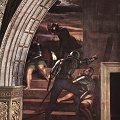 Get
Get  a high-quality picture of
The Liberation of St. Peter (Detail 2) for your computer or notebook. ‣
The story in this fresco is broken down into three distinct episodes, taken from the Acts of the Apostles. The first (at left) shows the dismay of the guards: a soldier - whose armor reflects the light of the moon asks his sleepy and bewildered comrades what is going on.
a high-quality picture of
The Liberation of St. Peter (Detail 2) for your computer or notebook. ‣
The story in this fresco is broken down into three distinct episodes, taken from the Acts of the Apostles. The first (at left) shows the dismay of the guards: a soldier - whose armor reflects the light of the moon asks his sleepy and bewildered comrades what is going on.
The Liberation of St. Peter (Detail 3) (1514)
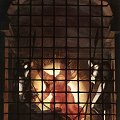 Get
Get  a high-quality picture of
The Liberation of St. Peter (Detail 3) for your computer or notebook. ‣
The story in this fresco is broken down into three distinct episodes, taken from the Acts of the Apostles. The second (in the centre) shows the appearance of the Angel of Freedom in the saint's cell.
a high-quality picture of
The Liberation of St. Peter (Detail 3) for your computer or notebook. ‣
The story in this fresco is broken down into three distinct episodes, taken from the Acts of the Apostles. The second (in the centre) shows the appearance of the Angel of Freedom in the saint's cell.
The Liberation of St. Peter (Detail 4) (1514)
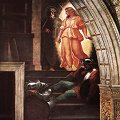 Get
Get  a high-quality picture of
The Liberation of St. Peter (Detail 4) for your computer or notebook. ‣
The story in this fresco is broken down into three distinct episodes, taken from the Acts of the Apostles. The third (at right) shows the bewildered Peter led by the hand of the divine messenger: the angel leads the stunned and still-sleepy St Peter past another sleeping guard.
a high-quality picture of
The Liberation of St. Peter (Detail 4) for your computer or notebook. ‣
The story in this fresco is broken down into three distinct episodes, taken from the Acts of the Apostles. The third (at right) shows the bewildered Peter led by the hand of the divine messenger: the angel leads the stunned and still-sleepy St Peter past another sleeping guard.
Room of the Fire in the Borgo
The room was used in the time of Julius II (pontiff from 1503 to 1513) for the meetings of the highest court of the Holy See: the Segnatura Gratiae et Iustitiae, presided over by the Pope. The paintings on the ceiling, by Pietro Vannucci, called the Perugino, commissioned by the Pope in 1508, are related to this function. At the time of Leo X (pontiff from 1513 to1521) the room was used as a dining room and the task of frescoing the walls was assigned to Raphael who entrusted a large part of the work to his school. The work was completed between 1514 and 1517.
The frescoes illustrate the political aspirations of Leo X through stories taken from the lives (narrated in the Liber Pontificalis) of two previous Popes with the same name: Leo III (Crowning of Charlemagne and Justification of Leo III) and Leo IV (Fire in the Borgo and the Battle of Ostia ). In all the episodes the Pope is a portrait of the reigning pontiff Leo X. Six seated figures of emperors and sovereigns who are protectors of the church are shown in the monochromes below the paintings.
The Fire in the Borgo (Detail) (1514)
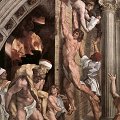 Get
Get  a high-quality picture of
The Fire in the Borgo (Detail) for your computer or notebook. ‣
The group in the left foreground, for example (made up of an old man on the shoulders of a young man, and a child), may be drawn from the episode of the Aeneid in which Aeneas escapes with his father, Anchises and his son, Ascanius. The nude descending from the wall at left recalls the heroic figures of Michelangelo.
a high-quality picture of
The Fire in the Borgo (Detail) for your computer or notebook. ‣
The group in the left foreground, for example (made up of an old man on the shoulders of a young man, and a child), may be drawn from the episode of the Aeneid in which Aeneas escapes with his father, Anchises and his son, Ascanius. The nude descending from the wall at left recalls the heroic figures of Michelangelo.
Room of Constantine
The room, that was designed to be used for receptions and official ceremonies, was decorated by the school of Raphael on the basis of drawings by the artist, who died prematurely before completion of the work (1520). It takes its name from Constantine (306-337 A.D.), the first Christian emperor to officially recognize the Christian faith, granting freedom of worship. On the walls are painted four episodes of his life which testify to the defeat of paganism and the triumph of the Christian religion: the Vision of the Cross, the Battle of Constantine against Maxentius, the Baptism of Constantine and the Donation of Rome.
The decoration of the room is completed by figures of great Popes flanked by allegorical figures of Virtue. The original wooden roof which Leo X (pontiff from 1513 to 1521) had built was replaced under Gregory XIII (pontiff from 1572 to 1585) by the modern ceiling, the decoration of which was entrusted by order of the Pope to Tommaso Laureti who portrayed the Triumph of the Christian religion in the central panel. The work was completed at the end of 1585 under Pope Sixtus V (pontiff from 1585 to 1590).
The Judgment of Solomon (1519)
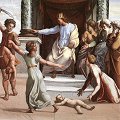 Get
Get  a high-quality picture of
The Judgment of Solomon for your computer or notebook. ‣
In the arch of the eleventh bay of the loggia there are four frescoes illustrating the story of Solomon. One of Raphael's workshop assistants designed and carried out the work, but it is not known which one. Raphael's own work on this theme in the Stanza della Segnatura is convincing because he confined himself to six beautiful single figures who play their role in the story with powerful expression. The scene in the loggia version, on the other hand, is developed within the space.
a high-quality picture of
The Judgment of Solomon for your computer or notebook. ‣
In the arch of the eleventh bay of the loggia there are four frescoes illustrating the story of Solomon. One of Raphael's workshop assistants designed and carried out the work, but it is not known which one. Raphael's own work on this theme in the Stanza della Segnatura is convincing because he confined himself to six beautiful single figures who play their role in the story with powerful expression. The scene in the loggia version, on the other hand, is developed within the space.
Vision of the Cross (Detail) (1520)
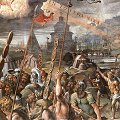 Get
Get  a high-quality picture of
Vision of the Cross (Detail) for your computer or notebook. ‣
The view of the "Tomb-pyramid of Romulus", which is no longer there, and the so-called Citadel of Sant'Angelo together with the bridge of Sant'Angelo, is an example of Raphael's interest in ancient Rome. The view Raphael has chosen more or less matches the view he had of Rome in 1520 from his Vatican loggie, which are located right behind the wall painted with the fresco. The Citadel of Sant'Angelo appears to be Raphael's reconstruction of the original ancient building, the erstwhile Hadrian Mausoleum, as it might have looked in the days of Emperor Constantine. By depicting this view of ancient Rome, Raphael is suggesting to anyone viewing that fresco that Constantine experienced his vision in the precise place where the Vatican State is now located. By this means Raphael was able to confirm in a very subtle manner, that the Popes had established themselves in Rome - more specifically - in the Vatican.
a high-quality picture of
Vision of the Cross (Detail) for your computer or notebook. ‣
The view of the "Tomb-pyramid of Romulus", which is no longer there, and the so-called Citadel of Sant'Angelo together with the bridge of Sant'Angelo, is an example of Raphael's interest in ancient Rome. The view Raphael has chosen more or less matches the view he had of Rome in 1520 from his Vatican loggie, which are located right behind the wall painted with the fresco. The Citadel of Sant'Angelo appears to be Raphael's reconstruction of the original ancient building, the erstwhile Hadrian Mausoleum, as it might have looked in the days of Emperor Constantine. By depicting this view of ancient Rome, Raphael is suggesting to anyone viewing that fresco that Constantine experienced his vision in the precise place where the Vatican State is now located. By this means Raphael was able to confirm in a very subtle manner, that the Popes had established themselves in Rome - more specifically - in the Vatican.
Raphael Art

|
|
More
Articles
 Art Encyclopedia A world history of art in articles.
Art Encyclopedia A world history of art in articles.
Renaissance
Raphael
Art, life and biography.
Frescoes in rooms of Vatican.
Religious paintings.
Madonnas.
Portraits.
Art
 Art Wallpapers Art image collections for your desktop.
Art Wallpapers Art image collections for your desktop.
Della Francesca Art, $19
(95 pictures)
Da Vinci Art, $25
(80 pictures)
Michelangelo Art, $29
(180 pictures)
Raphael Art, $25
(125 pictures)
Titian Art, $29
(175 pictures)
Durer Art, $25
(120 pictures)

